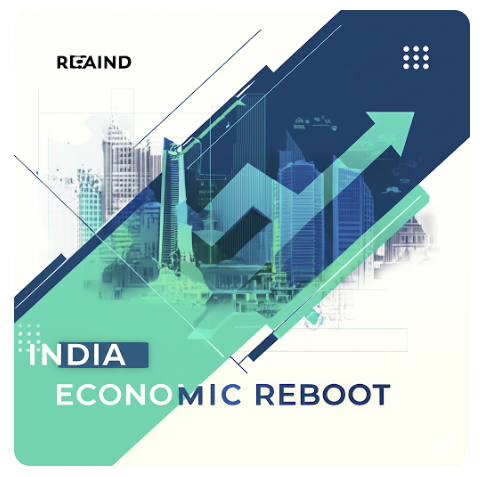Beyond the Headlines: What RBI's Rate Drop Really Means for You
RBI's Bold Stroke: Decoding the 50 BPS Rate Cut and Its Ripple Effect on India's Economy
Nagarjun
6/6/20256 min read


RBI's Bold Stroke: Decoding the 50 BPS Rate Cut and Its Ripple Effect on India's Economy
A Monetary Jolt for Growth
In a move that surprised many market watchers, the Reserve Bank of India (RBI) delivered a robust 50 basis points (bps) cut to its benchmark repo rate, bringing it down to a new three-year low of 5.50%. This pivotal decision, announced by RBI Governor Sanjay Malhotra following the Monetary Policy Committee (MPC) deliberations from June 4-6, 2025, marks the third consecutive rate reduction since February this year, culminating in a cumulative easing of 100 bps. Far from a mere technical adjustment, this bold stroke signals the RBI's unwavering commitment to invigorating economic growth and bolstering liquidity amidst a benign inflation outlook and persistent global headwinds. But what does this mean for India's financial landscape, our industries, and our wallets? Let's delve into the intricate layers of this monetary policy action.
The Rationale Behind the Radical Move: Inflation, Growth, and Global Dynamics
The MPC's decision was not a shot in the dark; it was a calibrated response to evolving macroeconomic realities. Two primary factors underpinned this larger-than-expected rate cut:
Benign Inflationary Environment: The RBI has significantly revised its Consumer Price Index (CPI) inflation forecast for FY26 downwards to 3.7% from an earlier projection of 4.0%. This lower projection reflects a sustained easing of price pressures, with headline inflation moderating to a six-year low of 3.2% in April 2025. Food inflation has been a key driver of this decline, coupled with a largely stable core inflation. With inflation comfortably within the RBI's target range of 4% (with a +/- 2% tolerance band), the central bank found ample room to prioritize growth.
Supporting Economic Momentum: While India's economic fundamentals remain robust, global uncertainties, particularly escalating trade tensions and geopolitical vagaries, necessitate a proactive approach to domestic growth. The RBI has retained its GDP growth forecast for FY26 at 6.5%, acknowledging the need to provide impetus to investment and consumption to sustain this trajectory. The 50-bps rate cut, coupled with a significant Cash Reserve Ratio (CRR) reduction, is explicitly aimed at stimulating the credit cycle and reviving demand.
A Shift in Stance: From 'Accommodative' to 'Neutral'
Interestingly, alongside the substantial rate cut, the MPC simultaneously shifted its monetary policy stance from 'Accommodative' to 'Neutral'. While seemingly contradictory to a large rate cut, this change is a strategic communication from the RBI. It suggests that while the current focus is on supporting growth through easing, the central bank recognizes that the space for aggressive rate cuts might now be limited. Future policy actions will be even more data-dependent, carefully balancing growth imperatives with any potential resurgence in inflationary pressures or global shocks. This 'neutral' stance provides the RBI with greater flexibility to react to unforeseen developments without being perceived as locked into a continuous easing cycle.
The Dual Boost: Repo Rate Cut and CRR Reduction
Beyond the headline repo rate cut, the RBI delivered another crucial liquidity enhancing measure: a 100 bps reduction in the Cash Reserve Ratio (CRR), bringing it down to 3% from 4%. This reduction will be implemented in four equal tranches by December 2025. The CRR cut is projected to infuse approximately ₹2.5 lakh crore of primary liquidity into the banking system.
Impact on Financial Ratios (Banks): For banks, this dual action is a mixed bag. The CRR cut will significantly improve their liquidity position, lowering their cost of funds and freeing up capital that was hitherto locked with the RBI. This could potentially boost their Net Interest Margins (NIMs) in the medium term, as they have more lendable resources. However, the repo rate cut itself could put some pressure on NIMs if banks reduce their lending rates faster than their deposit rates. The increased competition for loans in a lower interest rate environment might also impact profitability. From a Capital Adequacy Ratio (CAR) perspective, the changes are indirect. Increased lending could lead to higher credit growth, which might necessitate more capital. However, the overall boost to economic activity could improve asset quality, reducing the need for provisioning for bad loans and thus positively impacting CAR.
Sectoral Impact: Short, Medium, and Long Term
The RBI's policy actions will reverberate across various sectors of the Indian economy.
Short-Term Impact:
Banking & Financial Services:
Borrowers: Immediate relief for those with floating-rate loans, especially home loans linked to external benchmarks (EBLR). EMIs will reduce, leading to higher disposable income. This is a significant boon for individual borrowers and small businesses.
Depositors: Negative impact. Banks will likely reduce fixed deposit (FD) interest rates, especially for shorter tenures, hitting the returns for savers.
Banks: Enhanced liquidity from CRR cut. Potential, though mild, pressure on Net Interest Margins (NIMs) due to faster transmission of lower lending rates compared to deposit rates. Increased demand for loans, however, could offset this.
Real Estate:
Homebuyers: Lower home loan EMIs significantly improve affordability. This is expected to immediately stimulate demand in the affordable and mid-income housing segments.
Developers: Reduced borrowing costs for project financing, easing financial strain and potentially accelerating project completion. This can help in inventory clearance.
Property Prices: Stable to moderately positive. The demand push could prevent further price corrections and even lead to slight appreciation in high-demand areas.
Auto Sector:
Consumers: Cheaper auto loans due to lower interest rates. This is a crucial demand driver, especially for entry-level vehicles where financing plays a significant role.
Manufacturers: Potential uptick in sales due to improved consumer sentiment and affordability. This can help clear existing inventory and encourage production.
Consumer Durables & Retail:
Consumers: Increased disposable income from lower EMIs on existing loans, coupled with cheaper financing for new purchases, will likely boost consumer spending on durables and discretionary retail items.
Businesses: Improved demand leads to higher sales volumes.
Manufacturing & Infrastructure:
Businesses: Lower cost of capital for expansion and new projects. This can encourage fresh investments and improve capacity utilization.
Project Viability: Capital-intensive projects become more viable, especially in infrastructure, where long-term financing costs are critical.
Medium-Term Impact:
Banking & Financial Services:
Credit Growth: Sustained lower rates and ample liquidity are expected to significantly boost overall credit growth, leading to higher loan books for banks.
Asset Quality: Improved economic activity could lead to better asset quality for banks, reducing non-performing assets (NPAs).
Profitability: As credit demand picks up, and transmission stabilizes, banks' profitability, indicated by Return on Assets (ROA) and Return on Equity (ROE), should see a healthy uptick.
Real Estate:
Sustained Demand: The positive momentum in housing demand is likely to continue, supporting new project launches and reducing unsold inventory.
Investor Confidence: Real estate may become an attractive investment option for those seeking higher returns than FDs.
Commercial Real Estate: Boost in economic activity will also benefit commercial and industrial real estate, leading to higher rentals and occupancy rates.
Auto & Consumer Sector:
Healthy Sales: Continued robust sales figures, especially if overall economic sentiment remains positive.
Capacity Expansion: Manufacturers might consider expanding production capacities to meet growing demand.
Manufacturing & Infrastructure:
Increased Investment: Lower borrowing costs encourage both domestic and foreign direct investment (FDI) in manufacturing and infrastructure, leading to job creation and technological upgrades.
Improved Competitiveness: Lower financing costs can make Indian products more competitive in global markets.
Government Borrowing:
Lower Yields: Reduced interest rates typically lead to lower yields on government securities (G-Secs), reducing the government's borrowing costs. This can free up fiscal space for more capital expenditure. The Debt-to-GDP ratio might see a slight positive impact from lower interest servicing costs.
Long-Term Impact:
Overall Economic Growth (GDP): The cumulative effect of sustained lower interest rates, increased liquidity, and stimulated demand is a stronger, more stable GDP growth trajectory. The RBI's focus on growth support aims to realize India's potential as the fastest-growing major economy.
Inflation Management (CPI): The RBI's cautious shift to a 'Neutral' stance indicates a readiness to adjust policy if inflation pressures resurface. This ensures long-term price stability, crucial for sustainable growth.
Investment Cycle: A prolonged period of favorable interest rates can kickstart a virtuous cycle of investment, production, and employment, fostering deeper industrial growth and a more robust domestic economy.
Financial Market Deepening: Lower interest rates and increased liquidity can encourage a shift in financial savings from traditional FDs to more market-linked instruments (e.g., debt mutual funds, equities), leading to a more diversified and mature financial market. This could also positively impact the equity market's Price-to-Earnings (P/E) ratios as corporate earnings improve and cost of capital declines.
Rupee Stability: While a rate cut can sometimes lead to capital outflows, the RBI's focus on domestic growth and stable inflation, coupled with India's strong economic fundamentals, aims to maintain Rupee stability in the long run.
A Calculated Move for a Dynamic Economy
The RBI's decision to cut the repo rate by 50 bps, coupled with the CRR reduction and a shift to a 'Neutral' stance, represents a well-thought-out strategy to propel India's economic growth engine. It's a clear signal of confidence in the benign inflation outlook and a proactive measure to cushion the domestic economy from global vulnerabilities. For the common person, it translates to cheaper loans and potentially more spending power. For businesses, it means easier access to capital for expansion and innovation. While fixed deposit holders might face reduced returns, the broader economic benefits of this expansionary monetary policy are expected to outweigh the short-term impact on savings. As India continues its journey towards becoming a $32 trillion economy by 2047, such decisive monetary policy actions will be crucial in building a resilient, dynamic, and globally competitive economic powerhouse.
to schedule a free introductory appointment
+91 81234 26999
FINSPIREYOU@OUTLOOK.COM
NEWSLETTER
© 2025 by Sukruthi Finspire You
Registration granted by SEBI (INA000020493) , Membership of Bombay Stock Exchange (BSE Enlistment number 2288), and certification from the National Institute of Securities Markets (NISM) in no way guarantee the performance of the Investment Advisor or provide any assurance of returns to Investors. Investments in the securities market are subject to market risks. Read all the related documents carefully.
ARJUN K A
pROPRIETOR sUKRUTHI
